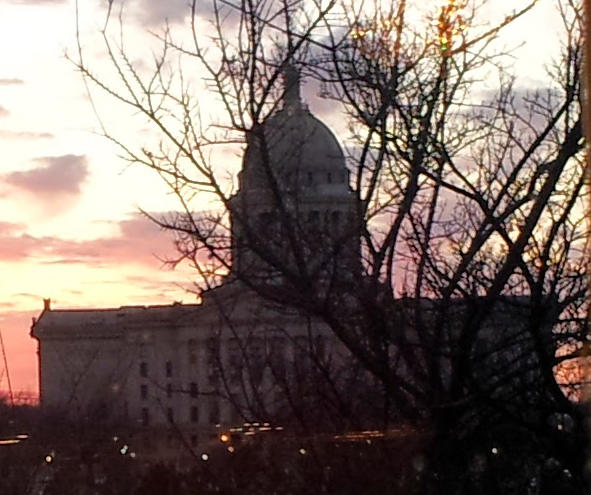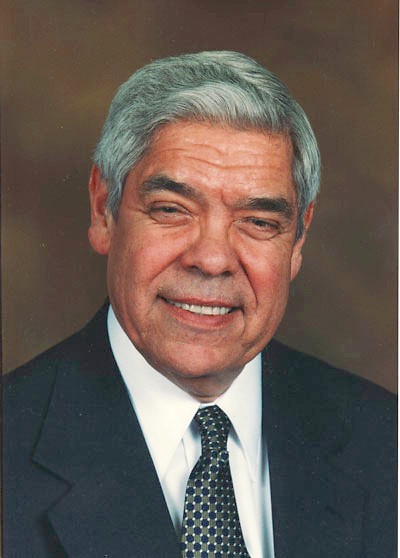Pictured: Oklahoma Judicial Center
Historic Retention Election Removes Oklahoma Judge
The statewide “NO” vote on Kauger was 723,931 votes (50.24%). There were 717,063 “YES” votes for her retention (49.76%). The two other Supreme Court justices that were also up for retention barely squeaked by and kept their seats for another six-year term. Justice James Edmondson, 79, retained his seat with 51.02 percent of the vote. Justice Noma Gurich, 72, retained her seat with just 50.27 percent.
What was different in this election was an active effort to publicize the liberal judicial record of the three judges. More on that later in this article.
In addition to the three Oklahoma Supreme Court justices, there were three Court of Criminal Appeals judges, and six Court of Civil Appeals judges on the statewide ballot. The Oklahoma Supreme Court is made up of nine justices. The Oklahoma Court of Criminal Appeals has five justices. The Oklahoma Court of Civil Appeals has 12 judges. These courts are called “appellate courts,” because they hear cases that have been appealed.
Unlike district judges and other judges that voters found on their local ballot who are elected, these 26 appellate court judges are appointed by the governor from a list chosen by the state Judicial Nominating Commission (JNC). This 15-member board includes six members appointed by the governor, six selected by the Oklahoma Bar Association, one named by the Speaker of the House, and one by the Senate Pro Tempore. The final slot is selected at large by the commission members themselves. Commission members serve six-year terms, staggered at two-year intervals. Members-at-large serve for terms of two years.
The argument for this system is that the JNC can closely examine the judicial qualifications of the applicants better than the general public. After screening and interviewing applicants, the commission recommends three candidates for the governor to choose from to fill vacant positions on the higher courts and also some vacancies when they occur on the lower courts. If the governor does not like any of the nominees, the governor can only ask the commission to submit a new list of nominees.
While the judges are appointed for life, they must stand for retention on six-year terms, which are staggered so that some portion of the state’s appellate judges face retention in every even-numbered election year. At the end of their terms, appellate judges wishing to remain in office must declare their candidacy for retention. When a judge seeks retention, the judge’s name is placed on the ballot at the next general election. If a vacancy occurs before their six-year term is complete, a person is named through the process to fill the remainder of that term, and then face a retention vote. Judges on the retention ballot cannot openly campaign and are not listed on the ballot by their political party. Voters can only select “YES” to vote to retain that judge, or “NO” to not retain that judge.
Because their elections are not competitive, the Oklahoma’s Code of Judicial Conduct does not allow appellate judges to raise campaign funds or establish campaign committees to support their retention.
In the nearly 60 years that this system has been in effect, no judge had ever lost a retention ballot election, until now. Judges have usually been retained in office with 59 percent to 67 percent of the vote.
When the Oklahoma Constitution was adopted in 1907, all judges were chosen through partisan elections. Then, in 1965, a bribery scandal involving three Oklahoma Supreme Court justices was revealed. In 1967, these justices were impeached, or resigned from office, after investigations determined the justices had accepted bribes in exchange for making favorable decisions in cases.
In 1940, Missouri became the first state to adopt the assisted appointment method, and it became known as the “Missouri Plan.” Oklahoma became the seventh state to adopt the Missouri Plan which was being pushed by progressives in both major political parties, the League of Women Voters, and the American Bar Association. On July 11, 1967, Oklahoma voters approved State Question 447 in the primary election by a narrow margin. This ballot measure amended the Oklahoma Constitution by adding Article 7B which established the current system. In 1987, the process was expanded to include the other appellate courts. And, in 2010 changes were made concerning the membership of the commission.
An attempt was made in the 2024 legislative session to replace the JNC with a method of selecting Oklahoma judicial officers which closely mirrors the federal system. Senate Joint Resolution 34 by Sen. Julie Daniels (R-Bartlesville) and Rep. Mark Lepak (R-Claremore) would have referred to a vote of the people a State Question to amend the Oklahoma Constitution to allow the Governor to nominate a person he believes to be qualified with confirmation by the Oklahoma Legislature. SJR 34 passed the Senate by a vote of 32-14 on March 12, but failed in the House 36-60 on April 16. So, the politically left-leaning Oklahoma Bar Association and others dominating the 15-member JNC continue to pre-select three nominees from which the governor is allowed choose.
Defenders of the present system argue that it has prevented another scandal. But if one were to carry that logic to its conclusion, we should have a Legislative Nominating Commission and a Governor Nominating Commission, removing the voters from accidentally choosing corrupt politicians. After all, governors and legislators are not above corrupt activities, as history has demonstrated.
For now, we operate under the system in which all the voters can do is to vote to retain, or vote not to retain, an appellate court justice. It has been difficult for voters to obtain information to make an educated decision on how to vote concerning retaining these judges. But last year the task became a little easier concerning the members on the Oklahoma Supreme Court up for retention.
The Oklahoma Council of Public Affairs (OCPA) is the state’s leading conservative think tank. Founded in 1993, the organization aims to build a state where taxes remain low, government interference is minimal, and traditional family values are protected from progressive influences. In advance of the November election, OCPA issued its first Oklahoma Judicial Scorecard which became an important resource for voters to understand how the Oklahoma Supreme Court rulings affect the state. The scorecard evaluated key rulings on issues such as tort reform, protection of unborn life, free speech, and public health mandates. Evaluation of the rulings offered critical insight into the court’s ideological leanings and how they may contrast with the state’s conservative majority.
The scores of the nine justices on the Oklahoma Supreme Court ranged from a low of 14% (Douglas Combs) to a high of 85% (Dana Kuehn). Based on their scores, the three justices up for retention last November were among the four lowest (most liberal) scoring members of the court. James Edmondson scored 21%, while Noma D. Gurich and Yvonne Kauger both scored 18 percent. Edmondson was appointed by Democrat Gov. Brad Henry in 2003. Gurich was named by Governor Henry in 2011. Kauger was appointed by Democrat Gov. George Nigh in 1984.
In addition to the information found on the OCPA Oklahoma Judicial Scorecard, the pro-life organization Oklahomans for Life reported: “Justices Kauger, Gurich, and Edmondson were all appointed to the state Supreme Court by pro-abortion Democratic governors, and all three have demonstrated through their rulings in abortion cases that they are firmly opposed to protecting the lives of unborn children.”
Unfortunately, the OCPA Oklahoma Judicial Scorecard did not cover the Court of Criminal Appeals, nor the Court of Civil Appeals, so those judges remained difficult to evaluate. In the absence of other information, a conservative voter might use the strategy of voting to retain judges picked by a Republican governor (and vote against those chosen by a Democrat governor), or vote them all out and hope that the Gov. Stitt could pick a better judge. However, the replacement would still have to have the approval of the generally liberal Judicial Nominating Commission.
Three of the six judges on the Court of Criminal Appeals were on the retention ballot in 2024. David Lewis was appointed in 2005 by Governor Henry (D). He was retained with 59.11 percent of the vote. William Musseman was appointed by Gov. Kevin Stitt (R) in 2022. He was retained with 64.3 percent of the vote. Scott Rowland was appointed by Gov. Mary Fallin (R) in 2017. He was retained with 63.71 percent of the vote.
On the Court of Civil Appeals, six of its twelve justices were up for retention. Robert Bell was put on the court by Governor Henry in 2005. He was retained with 58.75 percent of the vote. Timothy Downing was appointed in 2022 by Governor Stitt. He was retained with 64.99 percent of the vote. Brian Goree was appointed by Governor Fallin in 2012. He was retained with 59.29 percent of the vote. Jim Huber was appointed to the court in 2023 by Governor Stitt. He was retained with 64.53 percent of the vote. Bay Mitchell was a selection of Governor Keating in 2002. He was retained with 61.55 percent of the vote. Thomas E. Prince was appointed Governor Stitt in 2020. He was retained with 64.56 percent of the vote.
Kauger’s term ended on January 13 and the JNC received 14 applicants for the vacant seat. They will complete their process and submit three names to the governor. While Kauger’s District 4 seat covers the northwestern part of the state, for years she has lived across the street from the Oklahoma Judicial Center where the Oklahoma Supreme court is located.









Latest Commentary
Sunday 2nd of February 2025
Sunday 2nd of February 2025
Sunday 2nd of February 2025
Sunday 2nd of February 2025
Sunday 2nd of February 2025
Sunday 2nd of February 2025
Sunday 2nd of February 2025
Sunday 2nd of February 2025
Sunday 2nd of February 2025
Sunday 2nd of February 2025
Sunday 2nd of February 2025
Sunday 2nd of February 2025